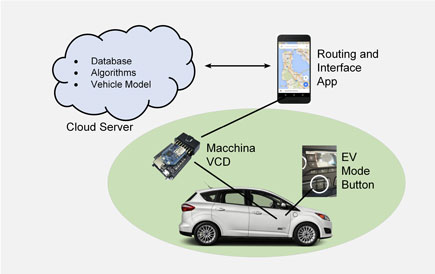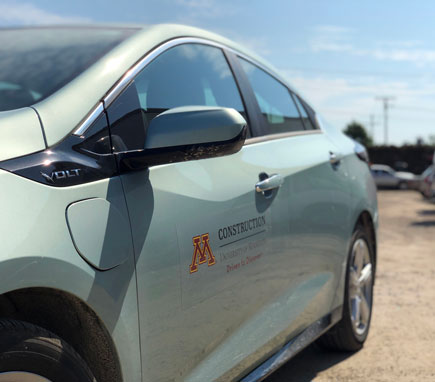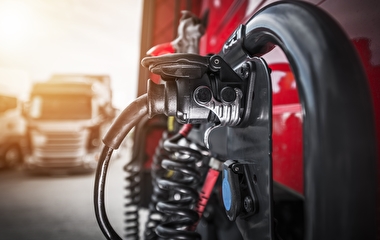the proposed implementation
Plug-in hybrid electric vehicles (PHEVs) represent a growing segment of the US passenger vehicle market, with more than 40 models available. These vehicles offer significant fuel savings, but there are tradeoffs, including uncertainty about how long the battery charge will last. In a recent project funded by the US Department of Energy (DOE) Office of Science, Small Business Technology Transfer Program, U of M researchers joined forces with a small automotive hardware developer to explore extending the battery range of these vehicles—and in doing so, increase both their fuel economy and appeal to consumers.
The research team was led by Earl Sharpe, co-founder of the Minneapolis start-up Macchina LLC, and Will Northrop, associate professor of mechanical engineering and director of the Thomas E. Murphy Engine Research Laboratory (MERL) at the U of M.
According to Northrop, the idea for this project sprang from other U of M work in progress involving hybrid delivery trucks. “We were developing algorithms that can optimize how frequently the engine charges the battery on board a delivery vehicle, and from there, save fuel, because it uses the engine less and the battery system more,” he explains. “We thought it would be interesting to take that same technology from delivery trucks and move it into passenger cars—in particular, plug-in hybrids.”
Plug-in hybrids have an electric motor and internal combustion engine that are used synergistically to reduce fuel consumption while maintaining a near-constant battery charge; they can also be charged externally to enable electric-only operation (EOO). However, how far a PHEV can be driven in electric-only mode before depleting the battery charge depends on a number of factors, such as driving style and the outside air temperature, Northrop says. So the goal of the current project was to increase the all-electric range by using a cloud-connected intelligent energy management strategy as an aftermarket solution for PHEV owners. “If you can get a higher all-electric range, then you’re saving fuel and money,” Northrop says.
The partnership combined Macchina’s expertise in vehicle communication device (VCD) hardware and the U of M’s expertise in vehicle powertrain and routing co-optimization (VPRO) technology. VPRO technology uses data (historical travel data plus information such as weather and traffic conditions), machine-learning algorithms, and modeling to determine when a plug-in hybrid should be in EOO mode for a given route.
The researchers designed a prototype VCD to collect the necessary vehicle data (such as vehicle speed, engine power output, and battery charge) and enable EOO mode in the test vehicle, a Chevrolet Volt. Data were collected from the vehicle on a representative commuting route of 20.7 miles. The team then created a vehicle model with the data to simulate energy consumption when driving in “normal” (EOO) mode versus fuel consumption in “hold” (charge-sustaining) mode.
The researchers simulated the commuting route using the model with different settings and estimated a miles-per-gallon fuel reduction of between 3.3 and 8.9 percent with the technology—and they believe the approach would be valid for other PHEVs besides the Volt.
The proposed implementation, Northrop says, would be a smartphone app that would alert the PHEV driver to the ideal time to be in a given powertrain operating mode.
Besides having interest for governmental agencies, fleets, and other potential customers, the results will inform future U of M research, Northrop says. “We’re looking at different types of vehicles and how to apply what we’re doing. All these projects kind of build on each other,” he says.
Sharpe says this was Macchina’s first time being involved on the research side of a project, rather than simply supplying the hardware University researchers use. “Electrification seems like the way the world is heading in terms of automotive,” Sharp says. “It’s still in the really early stage. So it was great for a company like us to be involved in something new and cutting edge.”




